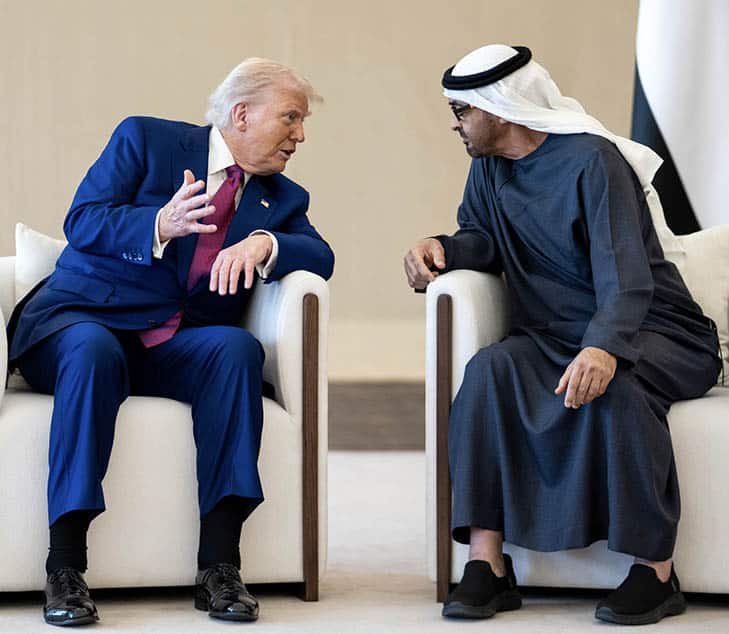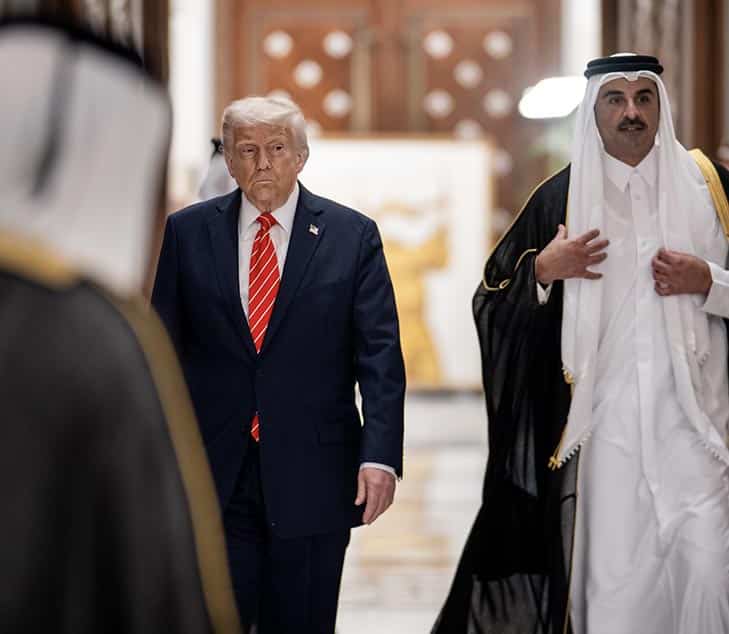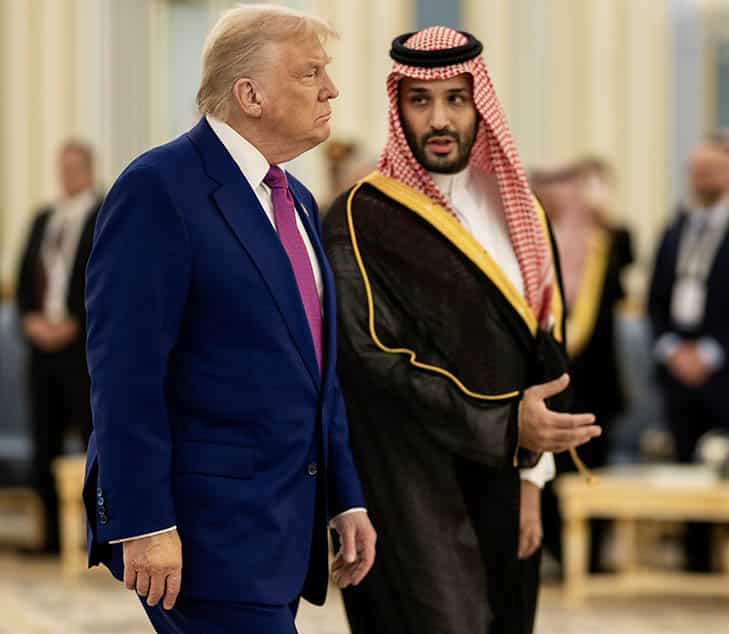The series of agreements recently signed by President Donald Trump with Saudi Arabia, the UAE, Qatar, and Egypt promises the United States significant geo-strategic, economic, and energy achievements. These agreements—at the top of Washington’s political and economic agenda—are reshaping America’s position in the Middle East, reinforcing its influence, and enhancing its regional and global image.
Arms deals and partnerships in energy, infrastructure, trade, and finance—alongside commitments for multibillion-dollar investments in advanced technologies and AI—create a complex web of security and economic interests between the U.S. and the region’s countries. They curb the spread of Chinese influence in the Middle East while positioning the U.S. as a global leader in energy and technological innovation. In a broader strategic view, these trade-security agreements—especially the defense contracts with Qatar and, likely soon, Saudi Arabia—reflect a clear trend of forming new bilateral alliances amid rising instability and security uncertainty. They also signal the emergence of a new geopolitical and geo-economic space in the Middle East, offering abundant business opportunities for American, Israeli, and other companies and influencing the balance among global powers as well as international trade and economics.
Riyadh: A New American–Saudi Anchor
“An enormous success”—this was how the White House described President Trump’s high-profile visit to Riyadh and the signing of a strategic economic partnership. The enthusiasm was justified: Saudi Arabia—the leader of the Arab-Muslim world, one of the U.S.’s largest trading partners, and among the world’s biggest importers of American arms and defense technologies—signed a $142 billion defense procurement deal with the United States. The agreement, which includes advanced weapons systems such as fighter jets, missile batteries, and air defense systems, enhances America’s military and security influence in the Persian Gulf. It also restrains Russian and Chinese activity (for example, in the civilian nuclear field) and helps Riyadh confront the threats of terrorism and Iran’s nuclear ambitions.
In addition, the two sides reached an understanding for cooperation in areas such as green energy, space exploration, mining, transportation, and nuclear energy—partnerships that deepen mutual interdependence and shared influence. Within its $80 billion national plan for transitioning to renewable energy, Saudi Arabia serves as an attractive destination for U.S. companies developing innovative carbon-reduction technologies. The kingdom also committed to investing $600 billion in advanced energy and technology infrastructure in the U.S. and to establishing a data center focused on AI and quantum computing—investments undertaken, among others, in collaboration with Oracle, Amazon, and Alphabet through Saudi Arabia’s sovereign wealth fund (PIF), valued at approximately $913 billion.
Given Saudi Arabia’s economic power (GDP of $1.27 trillion) and its position as the world’s second-largest crude oil exporter after the U.S., as well as its strategic location at the crossroads connecting Asia, Africa, and the Middle East, the agreements between Riyadh and Washington form a cornerstone in shaping the geo-economic landscape. From the American perspective, this partnership strengthens its strategic foothold in the Gulf and the broader Middle East, boosts U.S. industrial and economic growth, creates jobs, and expands business opportunities across key sectors.
These agreements contribute to Saudi Arabia’s economic growth and diversification, deepen U.S. involvement in the kingdom’s modernization process, and enable Riyadh to rely on Washington as a strategic base for ensuring energy security. At the same time, they maintain a steady supply of oil and gas to global markets, support energy price stability, leverage OPEC policies, and shape the “rules of the game” in energy markets. Moreover, the agreements consolidate America’s position as a global leader in energy and technology, strengthen the economic ties between Riyadh and Washington, and position the U.S. at the center of the regional innovation and development value chain.
Furthermore, the agreements intensify the interdependence between the American economy and security apparatus, as well as Saudi Arabia’s stability, consolidating U.S. control over Riyadh’s growth engines. They limit the maneuvering space of global competitors—especially from Asia, notably China—and position Saudi Arabia as a preferred partner within the American sphere. The agreements also increase Saudi Arabia’s security dependency on the U.S., distance it from the Chinese axis, and grant Washington long-term “leverage points.” In the long run, this raises the likelihood of substantial growth in both nations’ revenues and influence over regional issues such as conflicts, arms races, and normalization processes—developments that could reshape the Middle East map.
However, despite these advantages, the deepening interdependence between the two nations may also heighten rivalry among the Gulf monarchies and turn from an asset into a strategic liability for the U.S., particularly in the event of political shifts, internal instability, or public opposition. Only 34 percent of the Saudi public currently considers ties with the U.S. important, compared to 66 percent who prefer relations with China. This trend could pose diplomatic challenges for both Washington and Riyadh vis-à-vis their Gulf and international partners, especially amid growing internal power struggles for prestige and leadership among the Gulf states.

United Arab Emirates: Building a Unified Front Against Iran
During his historic visit to the United Arab Emirates, President Trump emphasized the importance of the long-standing strategic alliance between Washington and the United Arab Emirates. The agreements between the two nations establish deep cooperation in the fields of energy, security, aviation, space, and technology—especially in artificial intelligence—granting the United States a significant competitive advantage on the global stage.
The Emirati investment plan, totaling $1.4 trillion in the U.S. over the next decade, is expected to strengthen American industry and manufacturing, create hundreds of thousands of jobs, and accelerate innovation in high-tech, defense, and production sectors, among the major strategic projects: investments in American oil companies and natural gas infrastructure, the establishment of a $4 billion aluminum smelting plant in the U.S., and the creation of the world’s largest artificial intelligence campus outside the Emirates—an initiative positioning Washington as a global leader in developing advanced technologies.
These mutual partnerships and investments consolidate the UAE’s status and influence as a central player in both the regional and global arenas, while fostering interdependence that promotes shared interests. Such moves deepen regional alliance frameworks and ensure U.S. access to advanced technologies and vital energy infrastructure. In addition, they contribute to strengthening supply chains, industrial stability, and reducing dependency on foreign production—particularly in light of China’s growing presence, which accounts for roughly 30% of foreign direct investment (FDI) in regional countries, mainly in energy and petrochemicals.
The strategic cooperation helps cement U.S. technological and security dominance in the Middle East and positions it at the forefront of the digital revolution. According to a PwC report, artificial intelligence is expected to contribute more than $15 trillion to the global economy by 2030, with $320 billion coming from the Middle East, including a 14% contribution to the UAE’s GDP.
From a broader strategic perspective, the alliance with Abu Dhabi contributes to forming a unified Western front against Iran, despite trade between the two reaching nearly $27 billion in 2024, and promotes regional stability. The network of economic ties and agreements grants Washington access to new markets and renewable energy sectors in the Middle East and North Africa, expanding its geopolitical influence. Joint investments in green technologies and renewable energy help reduce oil dependency, strengthen energy security, and reinforce America’s position as a global leader in sustainability and energy innovation.
However, the UAE’s extensive investments—especially in sensitive sectors such as infrastructure, defense, and artificial intelligence—could impact the American economy and present regulatory challenges. Strengthening the alliance may also exacerbate tensions with other regional states, particularly Iran, and lead to geopolitical escalation. Moreover, cooperation with a non-democratic state lacking public oversight mechanisms could harm America’s image and undermine its legitimacy on the international stage.

Doha: Deepening Regional Security Partnership
President Trump’s visit to Doha also yielded a series of agreements between the Qatari leadership and the United States, worth $243.5 billion, alongside economic deals totaling $1.2 trillion in the defense, aviation, energy, and quantum technology sectors. This strategic move grants the U.S. significant advantages in the financial and energy arenas and consolidates its influence in the Middle East. The defense agreement signed between Washington and Doha, which includes an unprecedented commitment that any attack on Qatar would be considered a direct threat to U.S. security—similar to NATO’s Article 5 guarantee—marks a turning point in America’s relations with the Gulf monarchies. The agreement deepens the security partnership between the countries and positions the U.S. as a central actor in maintaining regional stability.
Upgrading the U.S. Al-Udeid Air Base with an investment exceeding $38 billion expands America’s strategic capabilities and strengthens its deterrence against Iranian threats and other hostile actors. Moreover, tightening the partnership positions Qatar as a potent regional mediator, assisting the U.S. in conflict resolution efforts—such as during the Gaza war, the confrontation with Iran, and mediation attempts in Afghanistan. In doing so, the Trump administration amplifies its diplomatic and economic leverage to support its assertive foreign policy.
Defense procurement deals worth $42 billion, including advanced THAAD air defense systems, bolster U.S. defense, space, and cybersecurity industries. Aviation deals between Qatar Airways and companies such as Boeing and GE, totaling $96 billion, contribute to the creation of hundreds of thousands of new jobs and strengthen American manufacturing supply chains.
Parsons Corporation, which secured regional engineering projects valued at $97 billion, provides advanced technologies for critical Gulf infrastructure, deepening the economic integration between the nations. At the same time, collaborations in high-tech and artificial intelligence generate synergy between American innovation and Qatari capital. The establishment of regional technology development centers enhances America’s competitive edge, increases its global market influence, and deepens Qatar’s dependence on U.S. innovation hubs.
Qatar—the world’s sixth-largest producer and exporter of natural gas—is expected to reach a GDP of $222.7 billion in 2025, with a growth rate of 2.9%. Its cooperation with the U.S. includes tens of billions of dollars in investments in LNG projects, green technologies, quantum energy, and intelligent grid management. Alongside strengthening supply chains and expanding production infrastructure, American companies are involved in developing new gas fields—a move generating jobs and significant revenue for both countries. In addition, as with other nations, the agreements with Qatar contribute to energy stability and consolidate the United States’ strategic position vis-à-vis Russia and China in both regional and global energy markets.
However, it is essential to note that American investments in Qatar’s energy infrastructure expose the U.S. to geopolitical risks, such as regional instability or the escalation of tensions with Iran. Furthermore, closer ties with Doha may provoke domestic criticism in the U.S. and cause friction with Riyadh or Abu Dhabi, which view Qatar as a regional rival. Therefore, despite being a powerful economic, security, and technological lever, the U.S. administration must balance advancing its global interests with managing geopolitical risks and maintaining internal stability.

Egypt: Preserving Peace with Israel – A Top American Interest
The agreements between the United States and Egypt, built on a longstanding strategic partnership, focus on maintaining Middle Eastern stability, strengthening Washington’s economic and energy position in the region, and improving Cairo’s security and financial standing. Egypt’s geo-strategic location—at the crossroads between the Mediterranean and the Red Sea—and its control of the Suez Canal, a vital global trade artery, grant the U.S. access to Egyptian and regional ports and bases, as well as influence over the movement of goods and military supplies between Europe, Asia, and Africa.
American aid to Egypt amounts to roughly $2.1 billion per year, of which $1.3 billion is military assistance. This includes over $5 billion in arms deals, such as the upgrade of Abrams 1A1M tanks and the supply of Hellfire missiles and precision-guided munitions. These measures strengthen the Egyptian military in its fight against terrorist organizations like ISIS and al-Qaeda operating in the Sinai Peninsula. In addition, logistical and intelligence cooperation between the U.S. and Egypt allows Washington to expand its military presence in the region and curb Iran’s influence, while reinforcing the moderate axis led by Israel, Jordan, Saudi Arabia, and the United Arab Emirates.
Egypt’s proximity to Israel, its mediation role with Hamas, and its involvement in reconstruction efforts in Gaza—including bolstering the Palestinian Authority and leading civilian projects—serve the American interest in regional stability. Maintaining peace between Israel and Egypt is considered a cornerstone of U.S. foreign policy, aimed at preventing military escalation and solidifying America’s role as a central mediator and financier in the region. Egypt, the second-largest economy in Africa (with a GDP of $347.34 billion and a projected 4.5% growth in 2025), is an emerging and attractive market for American exports in agriculture, technology, defense, and healthcare. Bilateral economic agreements enable U.S. companies to operate in Egypt under favorable conditions and invest in significant projects, including transportation, energy, water, and essential infrastructure. These investments contribute to Egypt’s economic and social stability, strengthen its regional role, and encourage further trade and foreign investment agreements.
Agreements with Egypt in the energy sector—particularly the recent $35 billion Israel–Egypt gas deal—enhance the U.S.’s geo-strategic standing and expand its access to regional energy markets. They contribute to stable energy supplies for Europe and global markets, especially amid geopolitical tensions with Russia and Iran. These agreements also establish Egypt as a key player in the gas and flow technologies sector, positioning it as a strategic regional energy hub.
American investments in green technologies and renewable energy, including solar energy, strengthen Egypt’s energy sector and help reduce its dependence on fossil fuels. Furthermore, these agreements create significant opportunities for leading U.S. companies and expand America’s influence across regional and global energy markets.
However, regional tensions—such as the escalation of the Gaza war, confrontation with Iran, or political instability within Egypt—may endanger energy infrastructure and undermine the stability of gas and oil supplies. Moreover, an increased American dependence on Egypt’s energy sector could reduce U.S. strategic flexibility and expose it to risks stemming from changes in Cairo’s government policy.
In conclusion, the agreements between the U.S. and Riyadh, Abu Dhabi, Doha, and Cairo provide Washington with significant geo-strategic, security, and economic advantages, including access to vital energy resources, emerging markets, diplomatic leverage, and extensive security cooperation. This network of partnerships strengthens U.S. influence in the Middle East and the Arab-Muslim world, expands business opportunities, and serves as a central tool for maintaining regional stability and addressing regional and global challenges, including those posed by Iran and Russia. At the same time, deepening dependence on Arab regimes exposes the U.S. to political risks and regional power struggles that could undermine alliance stability and harm its long-term interests. Therefore, a balanced, pragmatic, and measured American foreign policy is required—one that preserves U.S. strategic advantages while maintaining flexibility among the Gulf and Middle Eastern states.






